Link para o artigo original :https://www.bridgewater.com/research-and-insights/the-tightening-cycle-is-approaching-stage-3-guideposts-were-watching

Odds favor a third stage of this tightening cycle likely to be marked either by an economic downturn or failure to meet the inflation target, prompting more tightening. Either would be bad for most portfolios.
As economies have progressed through this tightening cycle, they have passed through two primary stages. First, when the markets recognized that MP3 policies had produced an overshoot with respect to spending and inflation, they discounted a coming tightening. Then central banks actually tightened. Second, as the tightening progressed, inflation peaked and then drifted lower. The markets discounted that the end was increasingly near and that within a few months we’d have 2% inflation and moderately positive growth, which would allow short-term interest rates to begin a steady two-year decline.
We were in sync with the first stage of this cycle and out of sync with the second stage, mainly because we were looking ahead to the stage after that. Now we are approaching either the soft landing or the beginning of a third stage. Given current conditions and the cause/effect linkages, odds favor that there will be a third stage and that it will mostly likely take the form of an economic downturn. And if that doesn’t happen, inflation is likely to remain above central bank targets, prompting a continued rise in short-term interest rates or at least a period of sustained higher interest rates than what the markets are now discounting. As an illustration, odds favor the below left chart, and if not that, then the below right chart, and maybe both.
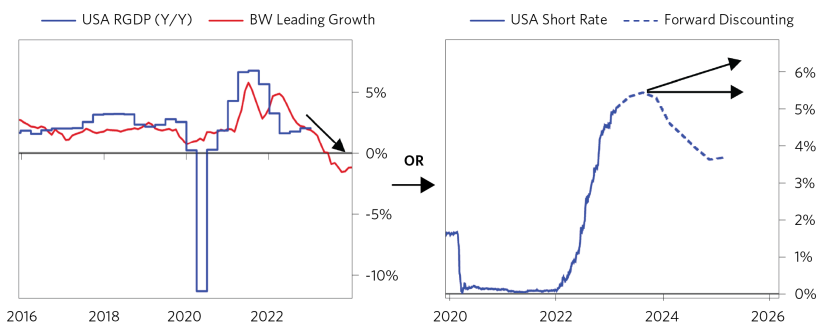
Given where we are, it’s worth looking at some of the key guideposts to see which direction we’re headed.
Going back before going forward: as shown below, the rise and then fall in inflation drove discounted tightening up and then down in the US and Europe. Recently, our estimate of inflation a year from now has stabilized and turned up a bit at about 3.5% in the US and 4.25% in Europe. That’s not low enough to end the tightening cycle or to allow short-term interest rates to fall. Discounted tightening has bumped up a bit given what’s going on.
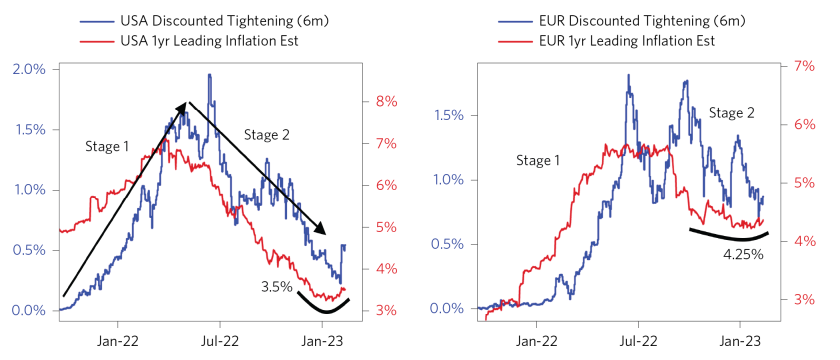
The tightening cycle has had a big impact on interest rates through the steady rise in the short-term interest rates and the up and down cycle in discounted tightening.
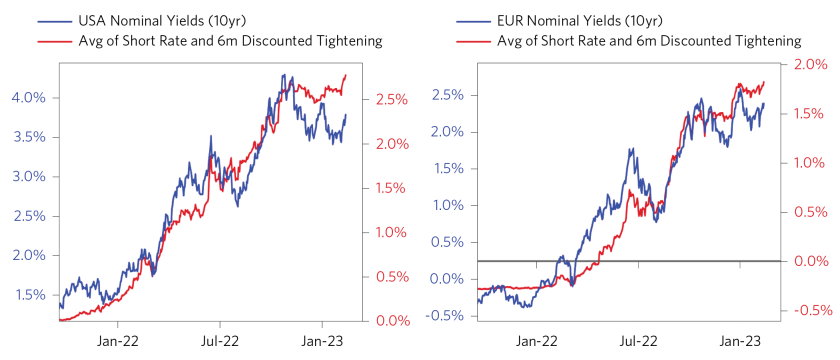
Discounted tightening has also had a big impact on the equity markets…
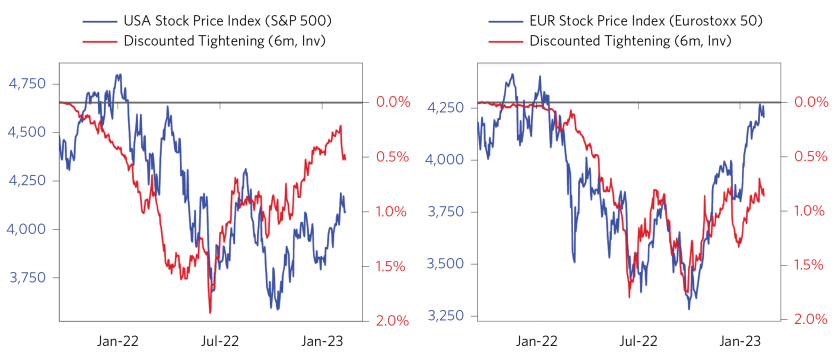
…and to a lesser extent the dollar.
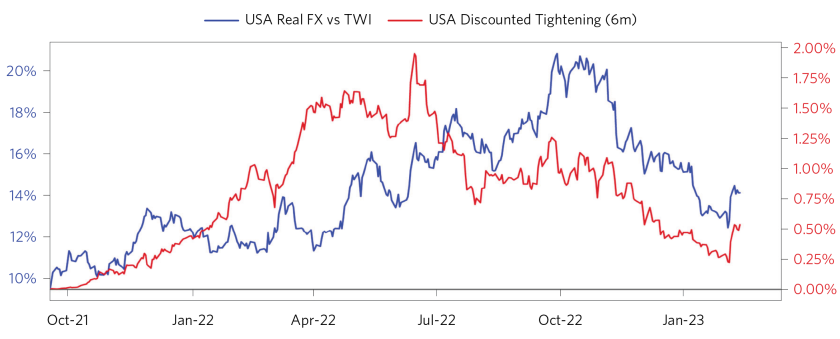
Going forward: in prior research, we’ve laid out what we think is a reasonable path to equilibrium. In a nutshell, we see it looking something like this.
- To get 2% inflation, you need a deceleration in wage growth from the prior 5% to about 2.5%.
- To reduce wage inflation, you need to cut nominal spending and income growth in half to 3-5% and raise the unemployment rate by 2% or more.
- To raise the unemployment rate, you need to drive nominal GDP growth materially below wage growth and compress profit margins enough to produce about a 20% decline in earnings.
- After that, you need to hold short-term interest rates steady for about 18 months, until 2.5% wage growth, 2% inflation, and 2% real growth are sustainably achieved.
- Then cut short-term interest rates to about 1% below then-existing bond yields.
So are we on track or not? Below, we scan through some of the guideposts we are looking at to assess where we are in the tightening cycle.
The Level of Nominal Spending Is the First Driving Force
We get an updated picture of nominal spending growth every week from two perspectives: the spending side and the financing side. Both suggest that nominal growth has stopped declining and has stabilized at around 7%, which is too high.

Has Nominal Spending Fallen Below Wage Growth? No.
When nominal spending growth minus the hiring run rate needed to grow the economy is above wage growth, corporate profits can be maintained and labor markets can grow. If labor markets grow, you don’t get a contraction in incomes to bring spending down, and wages can stay high. Timely reads suggest spending remains too high relative to wage growth to slow wages down.

Are Job Openings Falling? They Were, But Have Recently Risen Again.
Demand for labor as measured through openings is one of the better indicators of the supply of labor and subsequent wage growth. While there has been some cooling in openings over the past year, the last few months have seen a bounce.
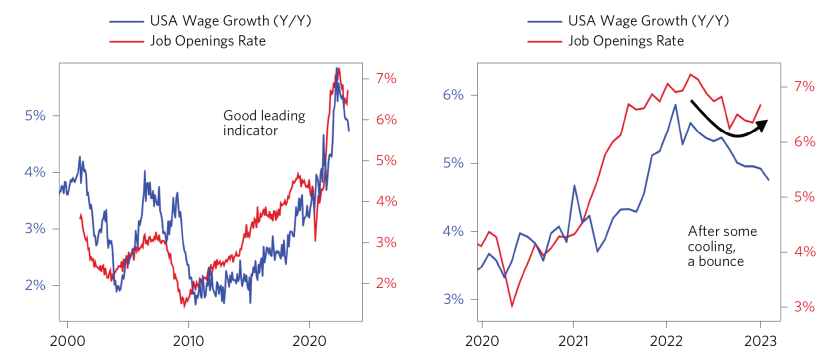
Business Sources of Funds Are Drying Up, a Threat to Business Hiring and Spending
When you look at the economy, households do the bulk of the spending, and businesses do the hiring. The hiring provides income to the households, which they spend. Given labor markets, household incomes have supported a steady growth in nominal spending. However, business sources of funds from profits and credit have rolled over and turned negative. As you would expect, when this happens, they cut back first on buybacks and M&A, then on capex, and last of all hiring. This is an indication that we’re close to the line with respect to a downturn.
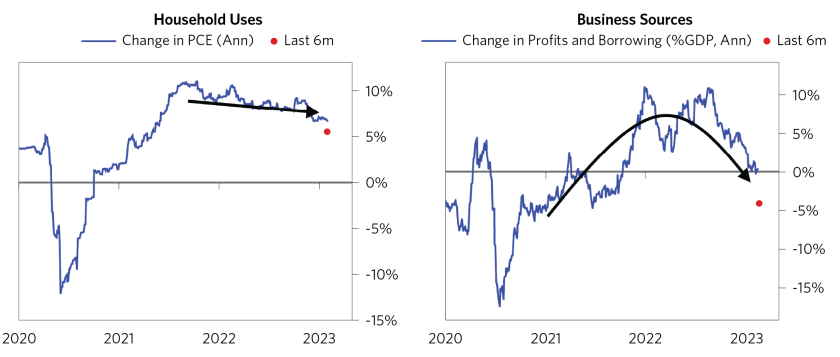
But Earnings Have Not Yet Fallen Enough to Produce a Contraction in Labor Markets
As we have discussed in prior research, earnings need to fall in order to induce the layoffs needed to cool the labor market and bring down wage growth, which is a prerequisite for a sustainable 2% inflation rate. After cooling late last year, our weekly reading of earnings growth has bounced rather than accelerating downward.

These guideposts suggest that the soft landing is not imminent and that a third stage in the tightening cycle lies ahead, where interest rates will stay high or higher in contrast to the steady decline that is discounted to begin in the middle of this year.
Other Observations: The Reversion of Spending on Goods Versus Services Is Exerting an Influence
Another interesting influence is the reversion in consumption patterns from goods back to services. As shown below, after spiking in the early stages of the reflationary recovery from the pandemic, real goods demand has been weak. Meanwhile services demand has recently been strong, with modest scope for continued reversion.
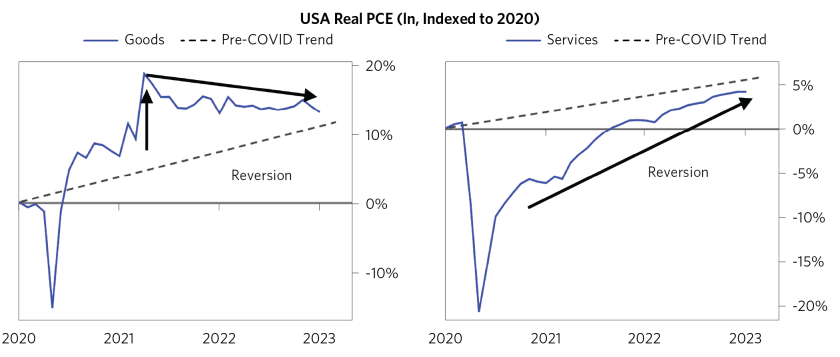
This is showing up clearly in the monthly personal consumption statistics. Nominal spending on services has continued to grow at a rapid clip of about 6% annualized. Real and nominal demand for goods has been gradually weakening. This shift in the mix of demand has implications. Services spending is an upward pressure on employment and wages, while weak goods demand has a more pronounced impact on listed company sales.
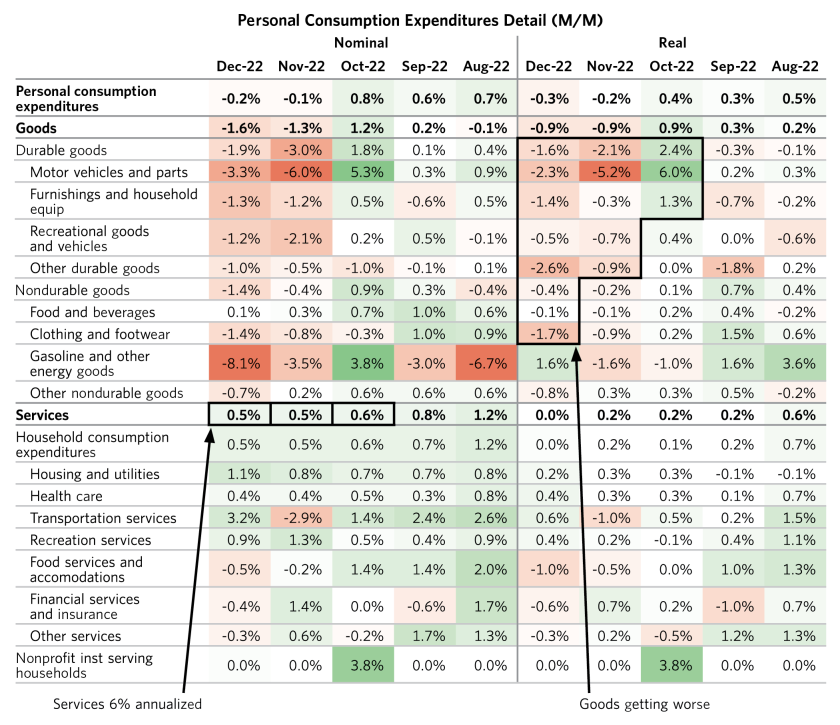
A diffusion index of monthly real PCE goods demand has been a good filter of recessions. As shown below, since 1960, in each of the six prior cases that the diffusion index was negative, there was a contraction in growth. On the other hand, when growth dropped negative but the diffusion index was positive, the apparent downturn quickly reversed. The diffusion index recently breached the zero line for only the seventh time since 1960—another indication that we’re headed for a third stage of the tightening cycle.

This research paper is prepared by and is the property of Bridgewater Associates, LP and is circulated for informational and educational purposes only. There is no consideration given to the specific investment needs, objectives or tolerances of any of the recipients. Additionally, Bridgewater’s actual investment positions may, and often will, vary from its conclusions discussed herein based on any number of factors, such as client investment restrictions, portfolio rebalancing and transactions costs, among others. Recipients should consult their own advisors, including tax advisors, before making any investment decision. This report is not an offer to sell or the solicitation of an offer to buy the securities or other instruments mentioned.
Bridgewater research utilizes data and information from public, private, and internal sources, including data from actual Bridgewater trades. Sources include BCA, Bloomberg Finance L.P., Bond Radar, Candeal, Calderwood, CBRE, Inc., CEIC Data Company Ltd., Clarus Financial Technology, Conference Board of Canada, Consensus Economics Inc., Corelogic, Inc., Cornerstone Macro, Dealogic, DTCC Data Repository, Ecoanalitica, Empirical Research Partners, Entis (Axioma Qontigo), EPFR Global, ESG Book, Eurasia Group, Evercore ISI, Factset Research Systems, The Financial Times Limited, FINRA, GaveKal Research Ltd., Global Financial Data, Inc., Harvard Business Review, Haver Analytics, Inc., Institutional Shareholder Services (ISS), The Investment Funds Institute of Canada, ICE Data, ICE Derived Data (UK), Investment Company Institute, International Institute of Finance, JP Morgan, JSTA Advisors, MarketAxess, Medley Global Advisors, Metals Focus Ltd, Moody’s ESG Solutions, MSCI, Inc., National Bureau of Economic Research, Organisation for Economic Cooperation and Development, Pensions & Investments Research Center, Refinitiv, Rhodium Group, RP Data, Rubinson Research, Rystad Energy, S&P Global Market Intelligence, Sentix Gmbh, Shanghai Wind Information, Sustainalytics, Swaps Monitor, Totem Macro, Tradeweb, United Nations, US Department of Commerce, Verisk Maplecroft, Visible Alpha, Wells Bay, Wind Financial Information LLC, Wood Mackenzie Limited, World Bureau of Metal Statistics, World Economic Forum, YieldBook. While we consider information from external sources to be reliable, we do not assume responsibility for its accuracy.
The views expressed herein are solely those of Bridgewater as of the date of this report and are subject to change without notice. Bridgewater may have a significant financial interest in one or more of the positions and/or securities or derivatives discussed. Those responsible for preparing this report receive compensation based upon various factors, including, among other things, the quality of their work and firm revenues.

